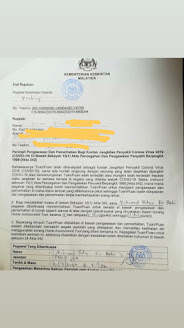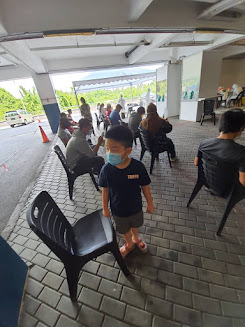2020年7月6号,
B爸打小烟花的日子。
小B幼儿园终于开课了。B仔还是继续宅在家线上上课。B爸终于不用每天早上一打二的一下跑书房(小B线上上课),一下跑客厅(B仔线上上课)。
小B学校规定得戴Face Shield上课。他觉得很紧,戴着一个早上不是很舒服,之后一个星期就开始戴口罩去上课。
听小B放学后聊说,班上从第一天开课18个同学的出席率,渐渐的从14,10 到剩5个学生去上课。
感觉第二波的疫情要开始了? 所以父母们又决定不把孩子送去学校上课?
还没开课,天天看妈咪group chat 喊要学校开课,一开学大家又临阵退缩,怕病毒,又没让孩子去上课。
毕竟孩子还是需要在一个合群的环境下学习,这和网上学习有很大的不同。
像小B这小瓜,开课了就很努力的学习,他希望每次听写都可以拿满分,这就是一个推动力,他喜欢和其他人竞争。这是他的个性。要赢不要输。有好有坏。简单来说就是比较好胜那一位,不过会知道要努力才有收获的那种。
----------------------------------------------
2020年7月27日晚上,
收到幼儿园的简讯通知家长们学校暂时关闭,因为有相关人士不幸验到中了COVID-19,不过是没有症状那种。
-----------------------------------------------------
2020年7月28日,
一早,B妈如常去上班。去公司的路途上有空挡,等红路灯时会瞄瞄简讯,怕错过什么紧急讯息。
平时B妈都是不太理会由幼儿园嘛嘛自己开的group chat,但无可否认,有时的讯息还是很有帮助下。
在看着mummy group chat 时,发现有妈咪说感染的小孩是小B的班!
当场吓着!学校为什么没有通知学生家长说是你小孩同学被感染,所以我们可能是高危险群,要先隔离啦什么的???!!!
当时很生气,要到公司门口,立刻转回家。打给老板报告一声。就立刻在家自行隔离。
很愤怒学校一点交代也没有。
B妈如何把车驾回家里,B妈也不知道。
为了不然周围的人们当心,也不知自己有没有病菌,隔离比较好。
就自己先居家隔离。做好自己本分。
---------------------------------------------------------
2020年7月29日,
一大清早,还没八点,B爸就接到学校牧师的电话。站在一旁的B妈双脚开始颤抖。
该来的电话终于来了。
B爸挂了电话,语气沉重的告诉B妈说,今天会有政府部门会打给我们,会安排小B去SWAB test。
跟惊讶的是。。。小B和那位感染者很靠近。。。
眼泪不听话的一直划过脸颊,叫它停,就是不肯。B妈担心指数破表。。。
心里满满的担心,很怕小B会被感染。。。
B妈就一直抱着电话,一听到电话响就赶紧接听。
中午,就接到从 PBK的工作人员打来,安排明天给小B去检查。。。
晚上,Dr.Theresa打来说Specialist明早不在,预约换到下午时间。
B妈开始失眠。
---------------------------------------------------------
2020年7月30日,
下午B爸就带小B到Klinik Kesihatan Petra Jaya检查。
花了两个多小时才轮到小B。
大多数是小B的同学和老师们。
看着B爸传来一张张现场照片,B妈的眼泪又不听话的滴滴答答落下。
担心小B肯不肯接受检查,怕他痛,怕他有阴影。
当嘛嘛的你,应该可以理解B妈的感受。
工作人员给了B爸一张小B的居家隔离信 Quarantine Order Letter (QOL)。
小B是PUI (Person Under Investigation),需隔离14天。日期从检验开始算起。也就是今天。
还有一张是给B妈的。B妈算是PUS (Person Under Suspect ),只需要隔离7天。日期从小B检验开始算起。
小 B是PUI,所以他需要做检查。我们是PUS,除非小B有事,我们才需要被检查。
很多人问我们有带上白色追踪手环吗?
答案是 : 没有。
手环只给从外国飞回我国的人士佩戴。
从1点多出门,到5点多才回到家。本来要买麦记冰淇淋奖赏勇敢没哭闹的小B,但那家麦记偏偏什么都没有,是不想做生意了吗?没冰淇淋,要把汽水换成MILO也不行。。。
---------------------------------------------
2020年7月31日,
假期。给我们一家都没差。
B妈煮累了(毕竟不是呆在厨房的料),开始订外卖。
GrabFood是B妈的好帮手。
订孩子们喜欢的Tamago Mentai,帮孩子解解闷。
我家外头放了一个桶。就在讯息里告知外送员把食物放在里头,零接触政策。
B妈逼不得已第一次用Apps买了日用品,食物。
结论,还是比较满意自己在超市选的蔬菜和水果。
App / website 里头的图片,看看就好。
孩子就没什么烦恼,玩玩水就很开心了!
----------------------------------------------
2020年8月1日,
接到一位卫生部的工作人员的调查电话。问小B为何被叫去检查(B妈还想问回她),什么事故,那段时间他去过那里等等等。。。
真的觉得是政府部门。。。完全没系统,还在manually把资料整理着。。。无言。
中午,有政府人员送来了B爸和B仔的Quarantine Order Letter。
B妈又想问,为什么小B检验那天,给了B妈和小B QOL, 做莫不一次过给其他两张?为什么要那么劳民伤财的聘请一个人员送没有用的信?
我们天天等KKM打来告知小B的检验成绩,告诉你们,不必等,不会有人打来的。
信可以送来家,为什么电话不能打一通告知我们成绩是negative 呢?
天天等成绩是很煎熬的事。
B妈今天补了麦记冰淇淋给小B。
闺蜜送来了住家肉包给我们一家打气,谢谢!
-----------------------------------------
2020年8月2日,
还在痴痴的等政府部门打来告诉我们成绩。
其实,他们不会打电话告知成绩的。
不能通知告知成绩,但可以派人员送QOL来家里。。。
怎样B妈也要硬着头皮煮给家里三个男人吃。
要方便就这种包装的。
不然这个也不错,孩子很喜欢。
-------------------------------------
2020年8月3日,
还在等电话。。。
不过早上在group chat 里陆续捎来好消息,不少家长报告说孩子们的成绩是negative。
傍晚,B爸WhatsApp给某位工作人员,告知小B第一个swab test是negative。
B妈心里头的第一个大石放下了。
第二个石头明天又要抬的高高的。
B妈已经失眠了几个晚上。
睡不着就煲韩剧。
看着【虽然是精神病,但没关系】。
第一集就会让你想努力的把剧追完。
俊男美女。好看!
B妈早上都会帮忙看住B仔和小B上Zoom和写功课。
------------------------------------
2020年8月4日,
很炎热的一天。
早上B爸带小B去第2轮的swab test。
很多人。
两父子就躲在车里吹冷气。
这次小B更勇敢了,嘴巴和鼻子的样本都有拿到。
他还很悠哉的告诉B妈不会怎么样。
回到家,B妈再买了麦记冰淇淋给小B。
看到B爸传来其他小孩还要爸爸抓,妈妈哄的局面。
孩子们的恐惧完全可以理解。
那么小就要面对这种体验。。。不容易。
我家小B没带给我们这种困扰就要很感恩了。
-----------------------------------------
2020年8月5日
B爸和B仔quarantine的最后一天。
明天他们可以出关了。
B妈的还要等到6号后才会解除。
为什么大家的日期不一样?
政府部门嘛,习惯就好。
-----------------------------------------
2020年8月6日
B爸可以出外了。
去跑步。然后打包食物给我们。
不用叫GrabFood了。(打烟花)
关关难过关关过。
傍晚,收到B妈的 Released QOL。
--------------------------------------
2020年8月7日
今天轮到B妈可以“出月”了!
不过小B的成绩还没出炉,为了大家的安全与顾虑,B妈拿多一天假。
宁可人负我,不可我负人。
一大早,陆续捎来好消息,成绩渐渐出炉。
孩子们都是negative,包括小B,B妈的小勇士。
中午才接到拿到答案。心头第二颗大石也丢进大海了。
孩子们和老师都negative。
在此要感谢学校有努力的跟随SOP。
下午,B妈立马去看中医。身体被击垮了。
这场战,一点也不轻松,完全是心里战。
---------------------------------------
2020年8月8日
终于可以晨跑了!
都说B妈是责任感很重的那种,第二次检验没出,B妈不敢轻易贸贸然的出外。
还约了闺蜜吃早点后才回家。
--------------------------------------
希望疫情快快过去,那么大家都可以恢复正常的生活方式,也不用咳两声,打一个喷嚏,就被身边的人用另外的眼神看待。
祝大家都平平安安的。



































看了你的文章我的头皮发麻, 当疫情离我们很近的时候。。。那个压力好大啊!
ReplyDelete还好没事。疫情就在身边多可怕,怎样躲都是PUI/PUS。
ReplyDelete希望大家可以做好本分。减少大幅传染的机率。
问题是,没有症状是最讨厌的。谁晓得几时中了。。。
没事就好!
ReplyDelete大家都辛苦了!
美國洛杉磯加州大學~等等~電子工程 電機工程~
ReplyDeleteScientists discover how oxygen loss saps a lithium-ion battery’s voltage
Measuring the process in unprecedented detail gives them clues to how to minimize the problem and protect battery performance.
By Glennda Chui
When lithium ions flow in and out of a battery electrode during charging and discharging, a tiny bit of oxygen seeps out and the battery’s voltage – a measure of how much energy it delivers – fades an equally tiny bit. The losses mount over time, and can eventually sap the battery’s energy storage capacity by 10-15%.
Now researchers have measured this super-slow process with unprecedented detail, showing how the holes, or vacancies, left by escaping oxygen atoms change the electrode’s structure and chemistry and gradually reduce how much energy it can store.
The results contradict some of the assumptions scientists had made about this process and could suggest new ways of engineering electrodes to prevent it.
The research team from the Department of Energy’s SLAC National Accelerator Laboratory and Stanford University described their work in Nature Energy today.
“We were able to measure a very tiny degree of oxygen trickling out, ever so slowly, over hundreds of cycles,” said Peter Csernica, a Stanford PhD student who worked on the experiments with Associate Professor Will Chueh. “The fact that it’s so slow is also what made it hard to detect.”
A two-way rocking chair
Lithium-ion batteries work like a rocking chair, moving lithium ions back and forth between two electrodes that temporarily store charge. Ideally, those ions are the only things moving in and out of the billions of nanoparticles that make up each electrode. But researchers have known for some time that oxygen atoms leak out of the particles as lithium moves back and forth. The details have been hard to pin down because the signals from these leaks are too small to measure directly.
lithium_ion_oxygen_migration_sv_final.jpg
Illustration of oxygen atoms leaving the atomic lattice of a lithium-ion battery nanoparticle as lithium flows in
Scientists at SLAC and Stanford have made detailed measurements of how oxygen seeps out of the billions of nanoparticles that make up lithium-ion battery electrodes, degrading the battery's voltage and energy efficiency over time. In this illustration, the pairs of red spheres are escaping oxygen atoms and purple spheres are metal ions. This new understanding could lead to new ways to minimize the problem and improve battery performance. (Greg Stewart/SLAC National Accelerator Laboratory)
“The total amount of oxygen leakage, over 500 cycles of battery charging and discharging, is 6%,” Csernica said. “That’s not such a small number, but if you try to measure the amount of oxygen that comes out during each cycle, it’s about one one-hundredth of a percent.”
In this study, researchers measured the leakage indirectly instead, by looking at how oxygen loss modifies the chemistry and structure of the particles. They tracked the process at several length scales – from the tiniest nanoparticles to clumps of nanoparticles to the full thickness of an electrode.
Because it’s so difficult for oxygen atoms to move around in solid materials at the temperatures where batteries operate, the conventional wisdom has been that the oxygen leaks come only from the surfaces of nanoparticles, Chueh said, although this has been up for debate.
To get a closer look at what’s happening, the research team cycled batteries for different amounts of time, took them apart, and sliced the electrode nanoparticles for detailed examination at Lawrence Berkeley National Laboratory’s Advanced Light Source. There, a specialized X-ray microscope scanned across the samples, making high-res images and probing the chemical
makeup of each tiny spot. This information was combined with a computational technique called ptychography to reveal nanoscale details, measured in billionths of a meter.
ReplyDeleteMeanwhile, at SLAC’s Stanford Synchrotron Light Source, the team shot X-rays through entire electrodes to confirm that what they were seeing at the nanoscale level was also true at a much larger scale.
A burst, then a trickle
Comparing the experimental results with computer models of how oxygen loss might occur, the team concluded that an initial burst of oxygen escapes from the surfaces of particles, followed by a very slow trickle from the interior. Where nanoparticles glommed together to form larger clumps, those near the center of the clump lost less oxygen than those near the surface.
Another important question, Chueh said, is how the loss of oxygen atoms affects the material they left behind. “That’s actually a big mystery,” he said. “Imagine the atoms in the nanoparticles are like close-packed spheres. If you keep taking oxygen atoms out, the whole thing could crash down and densify, because the structure likes to stay closely packed.”
Since this aspect of the electrode’s structure could not be directly imaged, the scientists again compared other types of experimental observations against computer models of various oxygen loss scenarios. The results indicated that the vacancies do persist – the material does not crash down and densify – and suggest how they contribute to the battery’s gradual decline.
“When oxygen leaves, surrounding manganese, nickel and cobalt atoms migrate. All the atoms are dancing out of their ideal positions,” Chueh said. “This rearrangement of metal ions, along with chemical changes caused by the missing oxygen, degrades the voltage and efficiency of the battery over time. People have known aspects of this phenomenon for a long time, but the mechanism was unclear.”
Now, he said, “we have this scientific, bottom-up understanding” of this important source of battery degradation, which could lead to new ways of mitigating oxygen loss and its damaging effects.
Chueh is an investigator with the Stanford Institute for Materials and Energy Sciences (SIMES) at SLAC. The Advanced Light Source, Stanford Synchrotron Radiation Lightsource and Spallation Neutron Source at Oak Ridge National Laboratory, where parts of this work were performed, are DOE Office of Science user facilities. Major funding came from the DOE Office of Energy Efficiency and Renewable Energy, Vehicle Technologies Office, and samples were provided by the Samsung Advanced Institute of Technology Global Research Outreach program.
Citation: Peter M. Csernica et al., Nature Energy, 14 June 2021 (10.1038/s41560-021-00832-7)
For questions or comments, contact the SLAC Office of Communications at communications@slac.stanford.edu.
SLAC is a vibrant multiprogram laboratory that explores how the universe works at the biggest, smallest and fastest scales and invents powerful tools used by scientists around the globe. With research spanning particle physics, astrophysics and cosmology, materials, chemistry, bio- and energy sciences and scientific computing, we help solve real-world problems and advance the interests of the nation.
SLAC is operated by Stanford University for the U.S. Department of Energy’s Office of Science. The Office of Science is the single largest supporter of basic research in the physical sciences in the United States and is working to address some of the most pressing challenges of our time.
Batteries
Chemistry & Catalysis
Materials Science
X-ray Science
X-ray Scattering/Diffraction
Energy Sciences Directorate
Stanford Institute for Materials & Energy Sciences (SIMES)
Lightsources
Stanford Synchrotron Radiation Lightsource (SSRL)
SLAC+Stanford